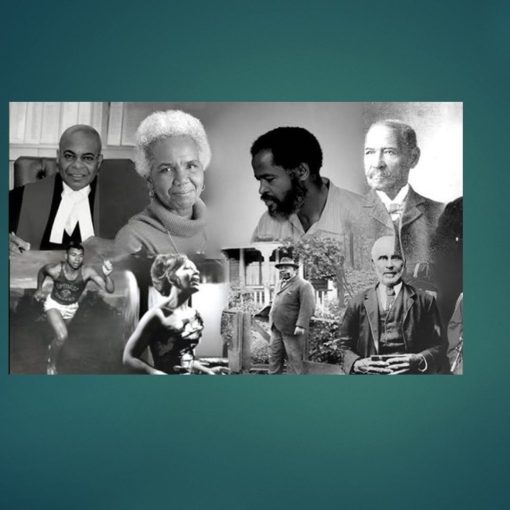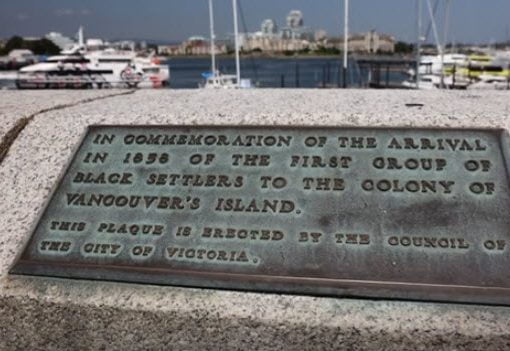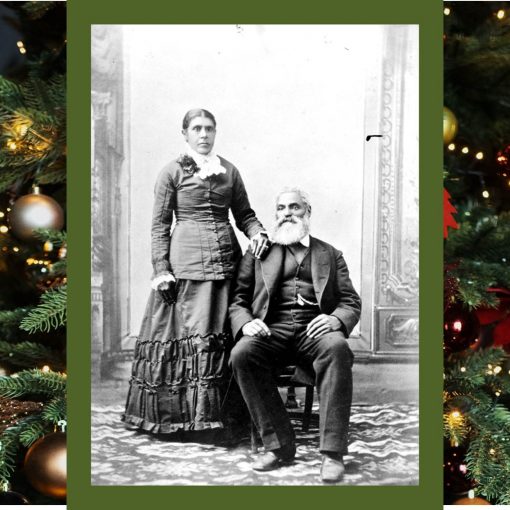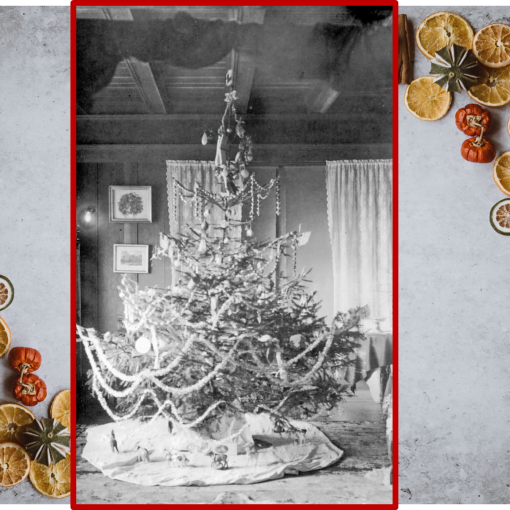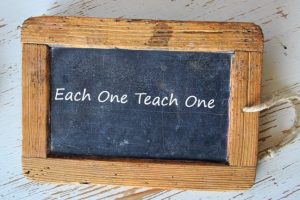
About the Proverb: Enslaved people were deliberately kept unaware or deceived about anything beyond their immediate circumstances as a means of control and dominance by “owners”, lawmakers and authorities. This control was not just physical harm/cruelty, isolation and oppression. Slave codes i.e. legislation and laws, were established to set restrictions and control on marriage, children, mobility, as well as making it illegal to learn or be taught to read or write. These controls also served to entrench in these authoritarian minds that enslaved persons were property.
In this article:
* Early education in British Columbia for these newcomers
* Noted Black pioneer influencers in education
* Community meetings and public speakers

Early Education in British Columbia for these newcomers
The Black newcomers to B.C. did not want segregated schools; this was one of the reasons why they had left the U.S. The school system in the Colony was varied. For example, private individuals and the Hudson’s Bay Company established schools and set their own attendance criteria. On Salt Spring Island community schools were established that were open to everyone.
Religious groups also established schools. In Victoria, The Sisters of St. Ann established two schools, one with minimal fees open for all students and the second school, (circa 1860) on Broad Street, to be made into a “Select School” with parents paying tuition. Blacks wanted to send their children to the Select School but were turned down; the Sisters and the white parent’s putting forward the argument their children would be uncomfortable. Bishop Demers attempted to intervene; but the parents of the white children who made up the major population of the Select School threatened to remove their children. The Bishop gave in.
By the mid-1860’s there was strong support for free common schools, open to everyone without exception. On Monday April 11, 1864 the Colonist reported on a meeting held in Victoria on Saturday, April 9th. “The Education Meeting” The article reports that about 500 people attended this meeting to discuss the proposed resolution for free Common Schools open to all. The article is detailed and extensive, including one attendee, John Costello “He would like to see all the children educated in a proper manner, and the blacks kept away from the whites, [hisses and laughter]. They might laugh but he had been as respectable a man as there was in the Colony, [roars of laughter]. The speaker (John Costello) was making further remarks against the colored population, when he was stopped by the Chair (Mayor Harris).”
The Legislative Assembly passed “An Act Respecting Common Schools” on May 15, 1865, providing for free, non-sectarian public schools.
Noted Black Pioneers and Influencers in Education
These educators and influencers are listed alphabetically; collectively their teaching/educating careers span more than 150 years.
Charles Alexander assisted in building the first public school in South Saanich (circa 1864) and he was also a trustee.
Norman Alexander, a great-grandson of Charles and Nancy Alexander was a biologist and taught at British Columbia Institute of Technology (circa 1965-1975). He also established a forest health consulting company and taught in the Nicola Valley.
*****
Leon Bibb “A Step Ahead”
In 1992 Bibb created a program called “A Step Ahead.” It was first performed at North Central Secondary School in Surrey, BC. and was performed in more than 20 schools across Canada. The program, designed to combat racism in the schools, combined Bibb’s iconic talent in singing and storytelling with spontaneous question-and-answer sessions that focused on racism issues teens were facing. This tour included schools in the Vancouver area, and other provincial communities.
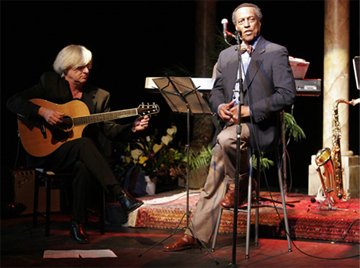
On May 16 and 17, 1995 Leon Bibb performed in Victoria at Victoria High, George Jay Elementary and Central Junior Secondary Schools. On Tuesday, May 18, 1995 Times Colonist reported: Bibb called the chance to work with students “one of the highlights of my career.” Bibb’s story
Jerry Bryant was an admired and respected teacher and a Victoria favorite as a renowned jazz pianist and singer.
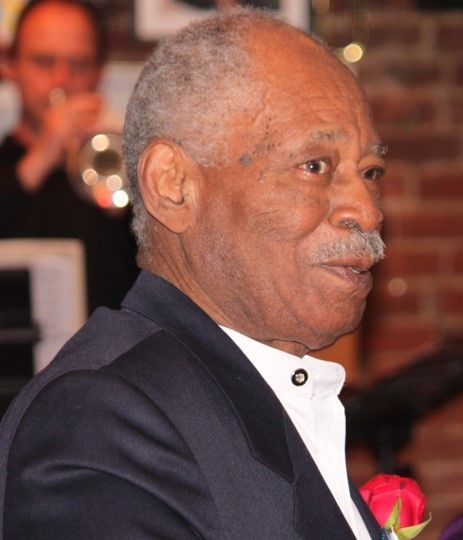
Receiving a degree from the University of Denver’s Lamont School of Music and a second degree from University of Alberta, Bryant’s teaching career spanned more than 25 years in Denver, Alberta and Victoria. “Victoria educator Jerry Bryant was ‘giant musical force,’ taught at Esquimalt High” Pedro Arrais, Times Colonist, September 7, 2021 in a tribute to Bryant on his death, August 19, 2021.
Just over 9 years previous, on Sunday, June 17th, 2012, at the age of 89, Jerry Bryant performed for our BCBHAS members, families and guests at a concert to celebrate Father’s Day.
This is the bio that Jerry provided in 2012 for that performance.
“Jerry first came to Canada in 1960, moving with his family from Denver, Colorado to Alberta. They then moved to Victoria in 1967. Jerry worked in Victoria at Esquimalt High School, where he taught English and formed the Esquimalt High Jazz Band which took many years of preparation and practice. Jerry had the opportunity to travel to many places with his students, including Ottawa, Los Angeles, Washington and many more destinations.” Bryant taught for 12 years at Esquimalt High and other schools before retiring in 1979.
Jerry also performed in many churches, hotels, resorts and produced a CD entitled “Feel The Love”. Jerry continued to perform with The Island Big Band and also took the time to visit many retirement homes throughout the city.
*****
Maria Gibbs, wife of Mifflin Gibbs and their children all attended Oberlin College. It was their 2 daughters, Ida and Harriet that became influencers in education.


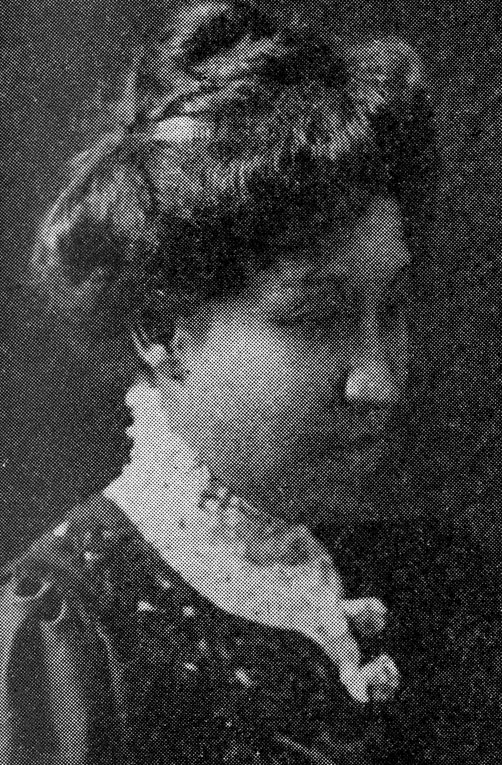
Maria (nee Alexander) Gibbs and her sister Louisa Lydia graduated in 1854 and 1856 respectively from Oberlin College. This College granted bachelor’s degrees to women beginning in 1841 in a coeducational program. After graduating, Maria taught school in Philadelphia circa 1855 to 1858. She met and married Mifflin Gibbs in April 1859 and moved to Victoria with him. “Thanks to her years at Oberlin, she was one of the best-educated women in the city.” Crawford Kilian
Ida (Gibbs) Hunt (b. Victoria, November 16, 1862) graduated in 1884, earned both Bachelor’s and Master’s degrees in English. Ida taught Latin and mathematics; she taught at Florida Agricultural and Mechanical University in Tallahassee and at M Street High School in Washington, founded in 1870 as the Preparatory High School for Negro Youth. She also became an activist promoting civil rights and women’s rights. With her marriage to diplomat William Henry Hunt in 1904, she travelled extensively, was fluent in French. Ida Hunt was the assistant secretary for the Second Pan-African Congress in Paris in 1919 and acted as a translator.
Harriet (Gibbs) Marshall (b. Victoria, 1868) attended the Oberlin Music Conservatory, where she completed the equivalent of a bachelor’s degree in music in 1889. She became an accomplished concert pianist, author, and educator. She founded the Washington Conservatory of Music in 1903.
*****

Barbara Howard, born and raised in Vancouver, graduated from UBC in 1959 attaining a B.Ed. and was the first member of a visible minority hired by the Vancouver School Board. She taught for 43 years, 14 of those as a physical education teacher, retiring in 1984. After retiring, she remained active in the community volunteering as a peer counsellor.
Harry Jerome is one of the most noted athletes in Canadian history. Jerome received his Bachelor of Science in physical education from the University of Oregon in 1964 and began teaching in British Columbia, first with the Richmond School Board (1964–65) and then with the Vancouver School Board (1965–68). In 1968, he received a Master of Science in physical education from the University of Oregon.
“The same year (1968), Jerome was appointed to the National Fitness and Amateur Sport Program. He designed a series of sport instruction manuals and in 1969 led a “Sports Demonstration Tour” to high schools across Canada. In 1975, he returned to British Columbia, where he developed the Premier’s Sports Awards program.” Tabitha deBrun, Canadian Encyclopedia “Harry Jerome”

John Craven Jones and his two brothers, William Allen and Elias Toussaint graduated from Oberlin College in 1856, 1857 and 1859 respectively. All three brothers came to Salt Spring Island.
John Craven Jones was the first teacher on Salt Spring Island circa 1859 to 1875. Jones was one of only 16 public school teachers in the Province at that time. Not only did he teach at 2 separate schools on the Island … he taught for 10 years without pay! Before coming to Salt Spring Island, Jones had taught for two years in a one-room school for Black students, in Xenia, Ohio and he continued to teach after leaving the Island and returning to the United States. His teaching career spanned more than 25 years.
“You can build your house of timber, You can build your house of stone. But the best foundation is a good education said our teacher Mr. Jones.”
Lyrics from the song “John Craven Jones” by local musician Phil Vernon ©2009
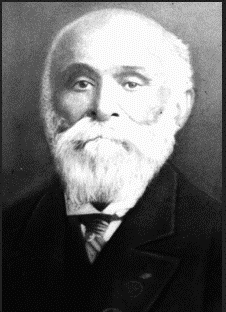
Peter and Nancy Lester were staunch advocates of the abolition of slavery. When the family were still living in San Francisco, they invited people to their home to educate them about their rights and teach anti-slavery songs.
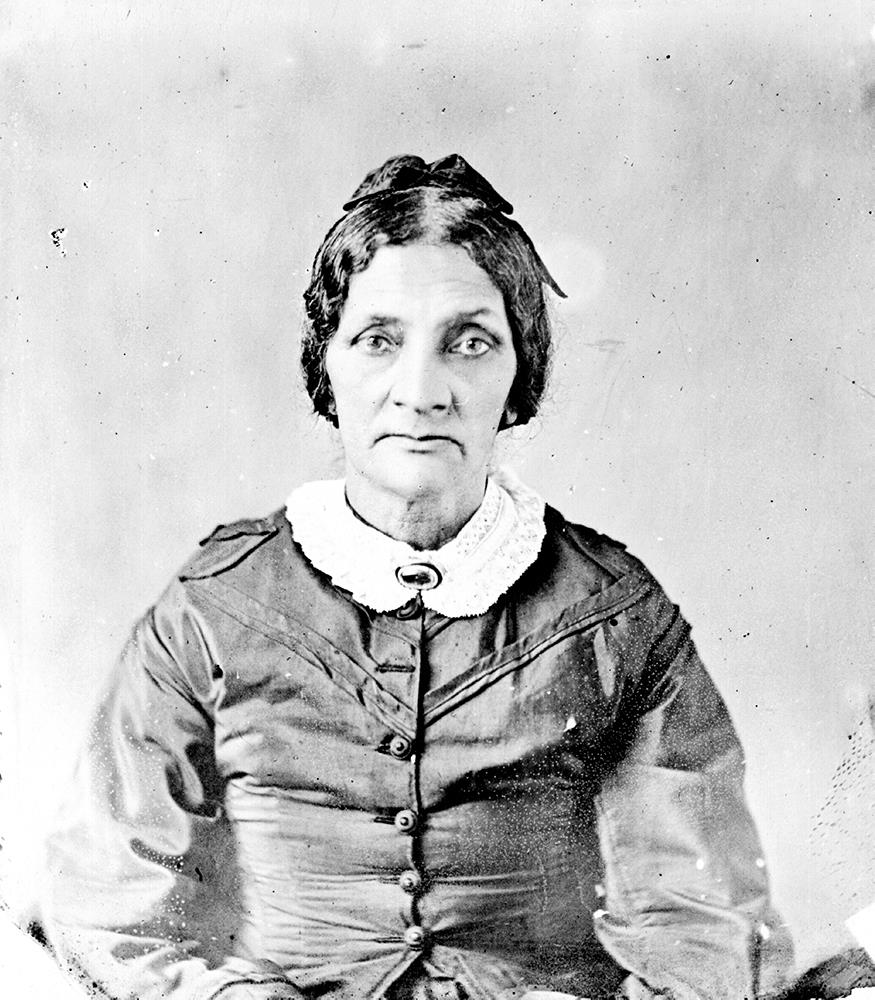
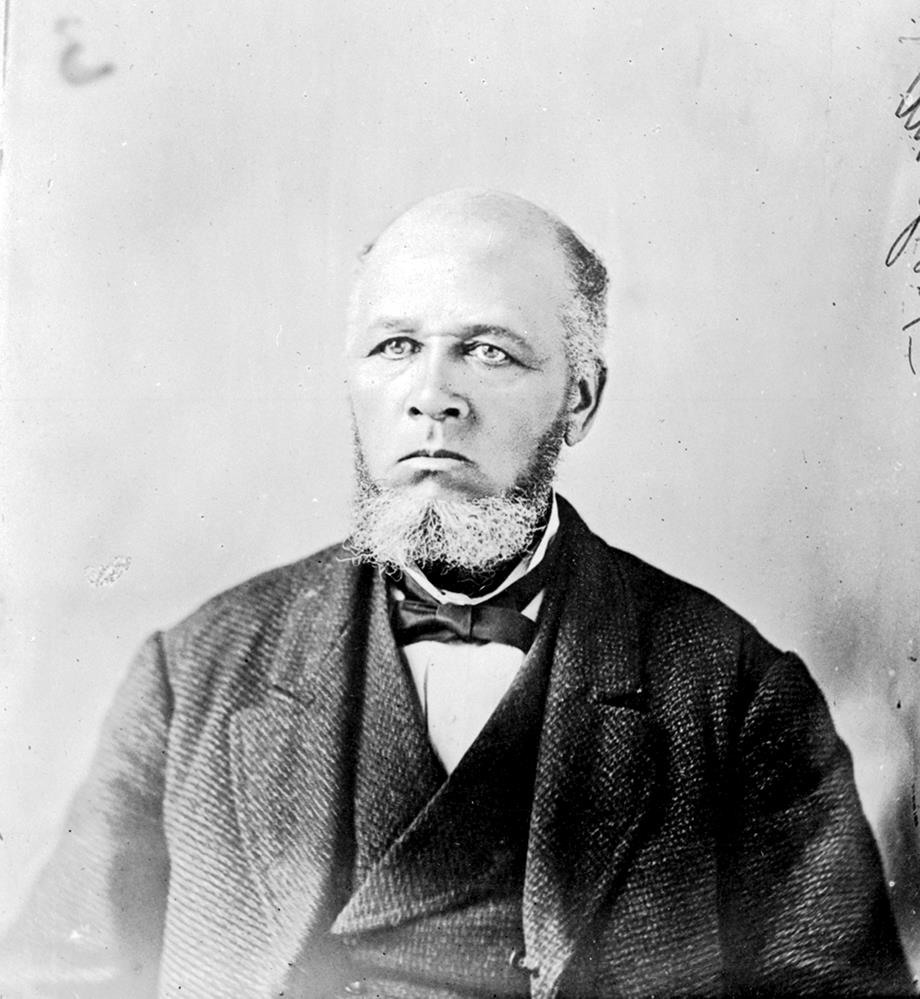
The family also met public controversy about their daughter Sarah’s schooling “because she was so light-skinned she could pass for white. Nevertheless, others knew she was Black because of her politically-active family.” In January 1858 an anonymous letter was received by the pro-slavery publication The San Francisco Herald, demanding Sarah be expelled because of her race. Sarah was expelled and the San Francisco Board of Education released a statement saying that Black students could only attend Black schools.
The Lester family arrived in Victoria in the late spring of 1858.
Sometime after arriving, Nancy wrote to her friend abolitionist William Still “it seems to be a providential provision for us who are so oppressed… that ere long we may find a home for our children in the right place.”
Frederick Douglas Lester, their son, was a teaching assistant with Jones on Salt Spring Island. In May 1864 Salt Spring residents sent a petition to Governor Kennedy requesting that Jones and Lester be granted a salary.
In November 1859, their daughter, Sarah posted this notice in the Victoria Gazette. “MUSIC. S.A. Lester begs leave to announce that she will give instruction on the piano. Residence Vancouver Street …”

*****
Selina Frances Smith was born in Ontario in 1858, she came to Victoria with her mother circa 1866, joining her father Moses Rowe Smith, who owned and operated a well-known and successful bakery and retail business. She attended school here, then Toronto College of Music, returned to Victoria and began advertising as a music teacher. Selina then went on to further studies in Leipzig, Germany; and on her return, restarted her studio. She is remembered as “highly esteemed musician, one of the oldest professional musicians in the city, enviable reputation as a teacher”. “The Life and Times of Selina Frances Smith” by Christeah D, Vancouver Island Local History Society.
About the Smith Family
*****
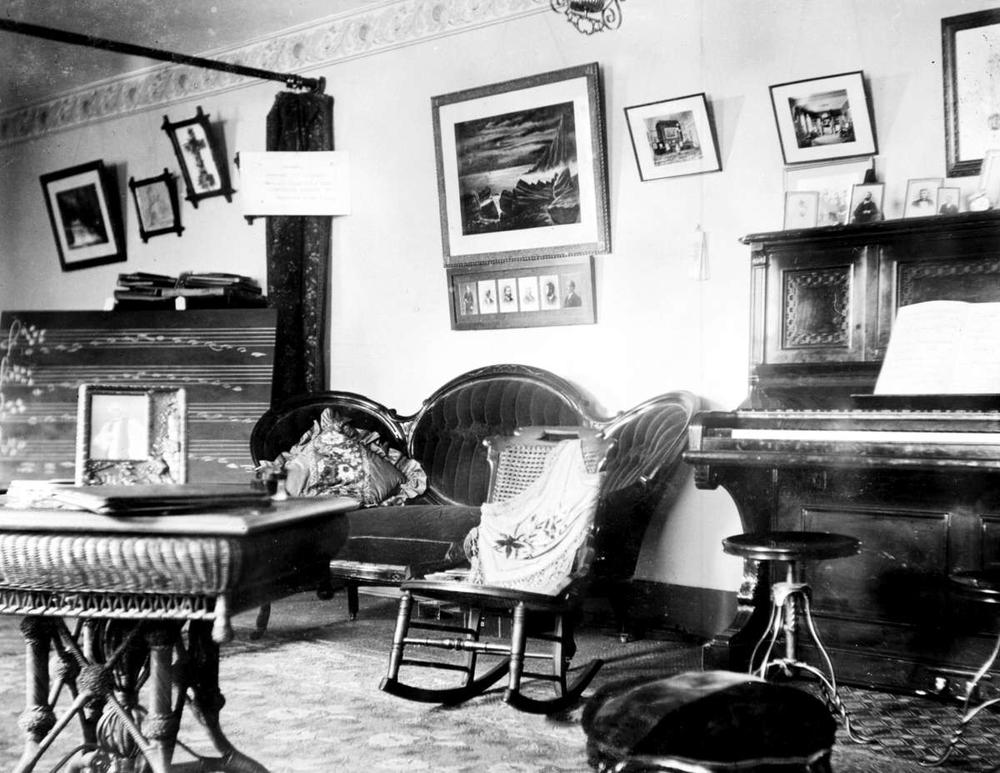
Ruby Sneed was an accomplished pianist, singer and teacher.
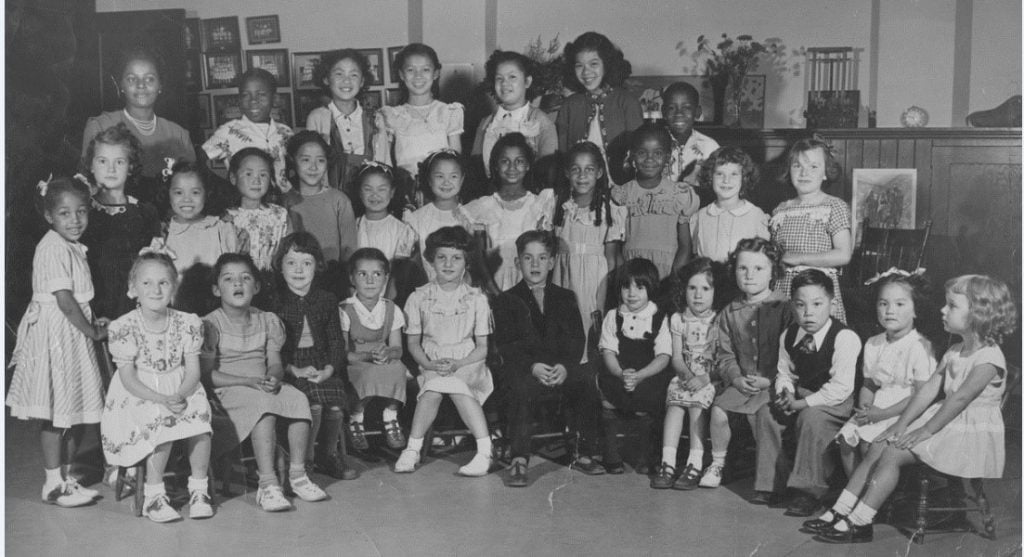
Image Courtesy of Theresa Lewis
Circa 1957 Ruby opened her own private studio in Vancouver. In 1972 a grant from the Community Music of Greater Vancouver (now known as Vancouver Academy of Music) enabled Ruby to travel to Japan where she observed firsthand the internationally renowned Suzuki Talent Education Method for piano students; on her return she organized the first Canadian Suzuki Piano Program at the Vancouver Academy of Music. The program was so successful she returned to Tokyo in 1974 with two of her students who performed in several recitals in Japan.
*****
Fielding Spotts was a trustee at the schools their eight children attended; Lake District School circa 1870 and then at the South Saanich School circa 1879 to 1884.
*****
Silvia Stark taught herself to read while enslaved to the Leopold’s in Missouri. “When their master’s children did their homework, she would listen. When they went out to play she would practice by herself. Mrs. Leopold would have been very angry if she had known as it was against the law to teach a slave.” Marie Stark Wallace “The History of the Stark Family” Gulf Islands Driftwood, 1979-1980


Emma Stark is Silvia Stark’s eldest daughter. In September 1874, at the age of 18 Emma starting teaching in a one-room school in the Cedar district, becoming the first Black teacher on Vancouver Island. This announcement was in the Nanaimo Free Press on August 1, 1874. “Cranberry-Cedar School, situated near the Nanaimo River bridge will be opened next Monday with Miss Stark as teacher.”
Marie Stark Wallace (1867-08-15 to 1966-06-15) is the third of four daughters of Silvia Stark. When Marie was in her nineties, she wrote the history of her family. After her death, it was published in The Gulf Islands Driftwood newspaper as an 11-part series in 1979-1980.
Community Meetings and Public Speakers
“The Colored Conventions”
Beginning in 1830 in the United States a series of gatherings; regional, state-wide and multi-state were being held and are known as The Colored Conventions and they continued until the late 1800’s.
According to the Colored Conventions archives “Over the course of seven decades, tens of thousands of Black men and women traveled to attend these meetings to discuss issues in education, health care, housing and justice systems“. One other by-product of these conventions is that they were reported in newspapers and this in turn helped fuel learning and knowledge sharing opportunities for Black communities across the US and Canada.
Black communities also published their own newspapers which served as a significant step for Black people to establish their own narrative about the Black experience.
Beginning in 1855, Black people in California held a series of state conventions “EQUALITY BEFORE THE LAW: CALIFORNIA BLACK CONVENTION ACTIVISM” Some of the delegates to these conventions would be immigrants to Vancouver Island including Edward A Booth, Jacob Francis, Mifflin Gibbs, Joshua Handy, William Delaney Moses, Nathan Pointer, and Fielding Smithea.
This practice of community meetings continued here in the Colony.
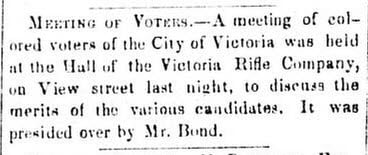
On Friday, July 17th 1863, there is a meeting of Coloured Voters of Victoria that took place at the Victoria Pioneer Rifle Corps Drill Hall “to discuss the merits of the various candidates”. The municipal elections took place on July 22nd.
The Victoria Pioneer Rifle Corps drill hall, owned and operated by the Corps, became a place for community meetings and social gatherings. On February 26, 1866 the community posted the following notice in the Colonist. “Literary Entertainment. To raise funds to establish a public library for the colored people of Victoria, an exhibition by colored children will be given in the Pioneer Rifle Hall. The entertainment will consist of speeches, recitations and singing. Admission 50 cents”.

In January 1865 Willis Bond placed an announcement in the Colonist newspapers “ATHENAEUM HALL. The Indefatigable Willis Bond is about to open a hall on Quadra street, between Fort and View streets which is to be devoted to public uses, such as political meetings, debates, &c.”

Over a period of more than two decades, Bond was a well-known orator and spoke at various public venues. Some of the speeches/debates included:
* Commercial Union with the U.S. (he was opposed to this).
* Meetings and debates by political candidates (municipal and legislative assembly)
* Borrowing money for city purposes
* The advisability of uniting the offices of mayor and magistrate
* Speeches against giving a government subsidy to the Mechanic’s Institute, which refused membership to Blacks
* With Victoria’s mayor, James Fell, Bond spoke against a resolution that was calling for the deportation of all Chinese in the province
* The merits and demerits of joining confederation and representation in Ottawa.
In 1865, Joshua B. Handy also organized a lecture at Bond’s ATHENAEUM on “The Present and Future Prosperity of the Coloured Race of the United States”. It is likely this community meeting was sparked by the Thirteenth Amendment, passed by the U.S. House on January 31, 1865 to abolish slavery “within the United States or any place subject to their jurisdiction”. Canada, as part of the British Empire had abolished slavery in 1834. Within a week of this lecture, on April 9th, 1865 the war is declared over and then 6 days later on April 14, 1865 President Abraham Lincoln is shot and died the following day on April 15, 1865.
SUPPORTING ORGANIZATIONS
The Negro Christian Alliance (NCA was established in the fall of 1910 by Harriet Blanche Davis and Milton P Fuller in Vancouver. The NCA organized regular community meetings where all were welcome to join, irrespective of race or religion. The group presented speakers and review papers, hosted discussions and debates, and provided opportunities for local talent to perform. The Alliance also organized debate and discussion over pressing political subjects of the day, from women’s suffrage to prohibition, and supported a Sunday school and numerous clubs and activities for about 150 youth.
The BC Association for the Advancement of Coloured People (BCAACP) was founded on March 1, 1958 to support people facing discrimination in education, housing and the justice system; to lobby for human rights legislation in the provincial parliament; and to bring about curriculum changes in BC schools.
Sources
– Slave Codes
– How Literacy Became a Powerful Weapon in the Fight to End Slavery
– Before the 1830s there were few restrictions on teaching slaves to read and write. After the slave revolt led by Nat Turner in 1831 all slave states except Maryland, Kentucky, and Tennessee passed laws against teaching slaves to read and write.
– A Highlight History of British Columbia Schools by Shirley Cuthbertson (Royal BC Museum and Archives)
– Sherry-Edmunds Flett. PHD thesis on the history of African Canadian women in British Columbia from 1858-1938. Chapter 3 (draft) “A Home for our Children in the Right Place”
– Natasha L. Henry. “Racial Segregation of Black People in Canada“. The Canadian Encyclopedia, 27 May 2019, Historica Canada
– Sisters of St. Ann
– The Colored Conventions Project and Convention documents
– California State Conventions: Equality Before the Law: California Black Convention Activism 1855-65
Image Credits
– Blackboard post image: Pexels-pixabay-159617
– Bryant: Jerry Bryant. Photo courtesy of Beth Cruise. Hermann’s Jazz Club April 1, 2013 for the celebration of Jerry’s 90th birthday.
– Gibbs: Harriet Gibbs Marshall. Image taken in 1936 By Maud Cuney-Hare, 1874-1936 – Negro musicians and their music by Maud Cuney-Hare. Washington, D.C.: The Associated Publishers, Inc., 1936, p. 254. Copyright not renewed, Public Domain
– Gibbs: Ida Alexander Gibbs Hunt. Image taken in 1918 By United States Government. – United States Passport Application Photo, which is copyright free., Public Domain
– Gibbs: Maria Gibbs Image Courtesy of Association for the Study of African American Life and History; and Crawford Kilian, Author “Go Do Some Great Thing: The Black Pioneers of British Columbia”
– Howard: Barbara Howard is being inducted @BCSportsHall (2012) in the Pioneer category. She is a LEGEND!” by miss604 licensed with CC BY-NC-SA 2.0
– Jones: John Craven Jones. Image 2005005001 Courtesy of Salt Spring Island Archives
– Lester: Nancy Lester. Image A-01627 Courtesy of Royal BC Museum and Archives
– Lester: Peter Lester. Image A-01626 Courtesy of Royal BC Museum and Archives
– Selina’s piano studio H-02519 Courtesy of Royal BC Museum and Archives
– Sneed: Ruby Sneed with her class at the Vancouver Chinese YMCA. Image courtesy of Theresa Lewis
– Stark: Emma Stark Image 989024010 Courtesy of Salt Spring Island Archives. Professional Photographer. Description: The photo is believed to have been taken at a portrait studio in Nanaimo on Vancouver Island, B.C.
– Stark: Maria and Silvia Stark: Courtesy of Salt Spring Island Archives

